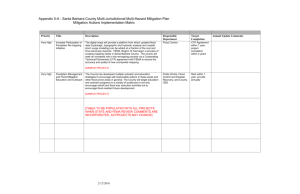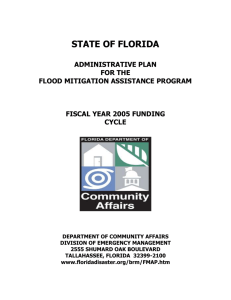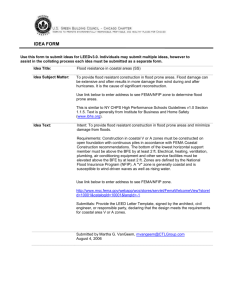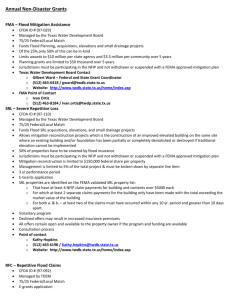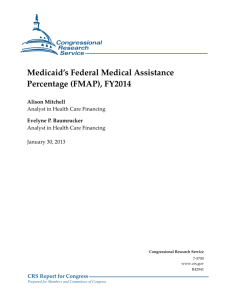FMAP 2005 WED INFO
advertisement
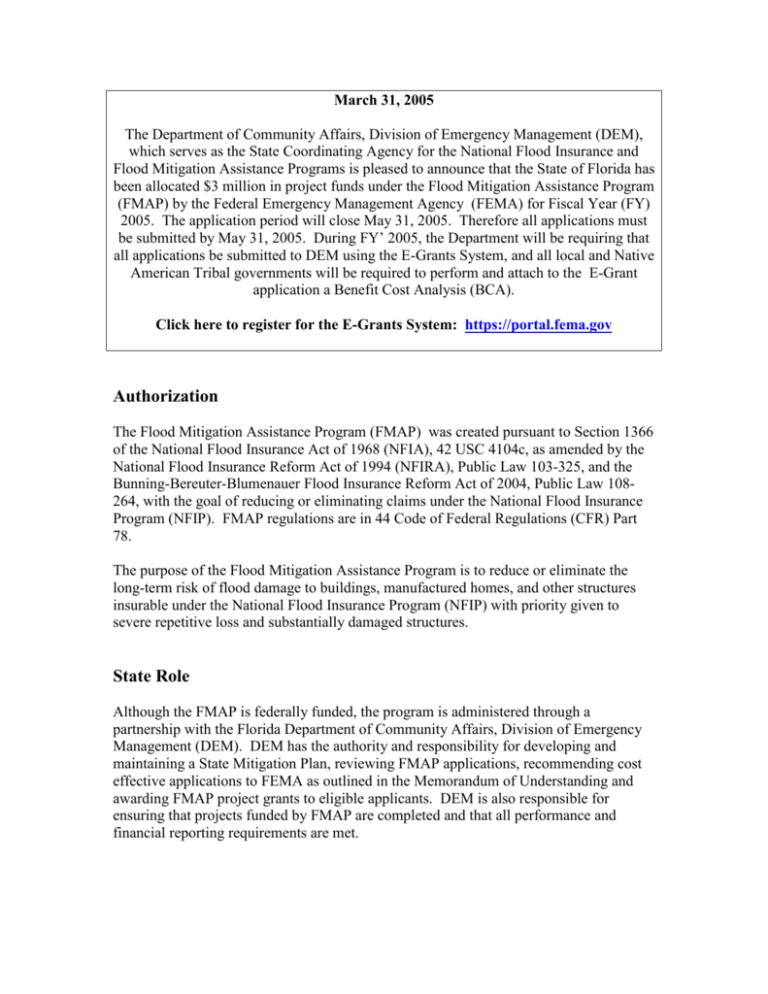
March 31, 2005 The Department of Community Affairs, Division of Emergency Management (DEM), which serves as the State Coordinating Agency for the National Flood Insurance and Flood Mitigation Assistance Programs is pleased to announce that the State of Florida has been allocated $3 million in project funds under the Flood Mitigation Assistance Program (FMAP) by the Federal Emergency Management Agency (FEMA) for Fiscal Year (FY) 2005. The application period will close May 31, 2005. Therefore all applications must be submitted by May 31, 2005. During FY’ 2005, the Department will be requiring that all applications be submitted to DEM using the E-Grants System, and all local and Native American Tribal governments will be required to perform and attach to the E-Grant application a Benefit Cost Analysis (BCA). Click here to register for the E-Grants System: https://portal.fema.gov Authorization The Flood Mitigation Assistance Program (FMAP) was created pursuant to Section 1366 of the National Flood Insurance Act of 1968 (NFIA), 42 USC 4104c, as amended by the National Flood Insurance Reform Act of 1994 (NFIRA), Public Law 103-325, and the Bunning-Bereuter-Blumenauer Flood Insurance Reform Act of 2004, Public Law 108264, with the goal of reducing or eliminating claims under the National Flood Insurance Program (NFIP). FMAP regulations are in 44 Code of Federal Regulations (CFR) Part 78. The purpose of the Flood Mitigation Assistance Program is to reduce or eliminate the long-term risk of flood damage to buildings, manufactured homes, and other structures insurable under the National Flood Insurance Program (NFIP) with priority given to severe repetitive loss and substantially damaged structures. State Role Although the FMAP is federally funded, the program is administered through a partnership with the Florida Department of Community Affairs, Division of Emergency Management (DEM). DEM has the authority and responsibility for developing and maintaining a State Mitigation Plan, reviewing FMAP applications, recommending cost effective applications to FEMA as outlined in the Memorandum of Understanding and awarding FMAP project grants to eligible applicants. DEM is also responsible for ensuring that projects funded by FMAP are completed and that all performance and financial reporting requirements are met. The State’s FMAP Administrative Plan and FEMA’s Fiscal Year 2005 FMAP Guidance governs how projects are selected for funding. The success in reducing future flood insurance claims depends upon the ability of our local and Native American Tribal governments to develop, maintain and implement long-term Flood Mitigation Plans. DEM will award grants to cost-effective and technically feasible projects that reduce future flood damage and benefit repetitively flooded structures, with priority given to structures identified on Florida’s Severe Repetitive Loss List. Applicant Eligibility Eligible applicants must: Participate in the NFIP; Having a FEMA-approved Flood Mitigation Plan, Community Rating System (CRS) Floodplain Management Plan or Local Mitigation Strategy; and Be able to meet the FMAP cost-share requirement. The following applicants are eligible for FMAP: State Agencies; Local and Native American Tribal governments. Local and Native American Tribal governments that have withdrawn or have been suspended from the NFIP are not eligible to receive FMAP grants. Project Eligibility Grants are available to local governments and Native American Indian Tribes to implement measures to reduce the risk of flood damage to NFIP-insurable structures. However, Indian Tribal governments and local governments that are suspended or withdrawn from the NFIP are not eligible for FMAP grants. The State of Florida will use project funds to fund cost effective flood retrofit and elevation of repetitively flooded and substantially damaged structures. More specifically, these project funds can be used for: (1) Acquisition and Demolition; (2) Elevation and Retrofit; (3) Acquisition and Relocation; (4) Dry Flood-proofing of Non-Residential Structures; (5) Beach nourishment; (6) Minor physical flood control projects; and (7) Other activities that bring a structure into compliance with 44 CFR 60.3. (8) Modified elevations (Not eligible under FY’ 2005) The above activities although eligible must meet the following minimum criteria in order to be considered for funding. The project must: Be cost-effective A project must be cost-effective and substantially reduce the risk of future damage, hardship, loss or suffering resulting from a major disaster. This requirement is satisfied by performing an analysis to determine whether the benefits to be gained are greater, or at least equal to the cost of the project. Be technically feasible The project must use design and construction methods and materials that are accepted by the design and construction industry Located in or benefits an NFIP-compliant community An eligible project must be located physically in a participating NFIP community that is suspended or withdrawn from the NFIP, and benefit such a community directly by reducing future flood damages. Conform with the State’s Administrative Plan Each applicant must have either a FMAP Plan, CRS Floodplain Management Plan or a Local Mitigation Plan. Conformance with these plans ensures that the proposed measure is in keeping with statewide mitigation strategies. In some cases, the proposed project may be identified within the existing plan. Comply with environmental laws, regulations and executive orders Comply with Executive Order 11988 (44 CFR Part 9 - Floodplain Management and Protection of Wetlands), 44 CFR Part 10 - Environmental Considerations and the National Environmental Policy Act (NEPA). Be in conformance with the minimum standards of the NFIP Floodplain Management Regulations 44 CFR, 60.3 and the local government CRS program, is applicable. Application Process An application for each project must be submitted to DEM by May 31, 2005. These applications must be submitted by DEM to FEMA by July 15, 2005. All applications must be submitted by eligible applicants and they will not be accepted from individual business and homeowners. Additionally, DEM will be requiring that all applications be submitted to DEM using the E-Grants System, and the local and Native American Tribal governments will perform and attach to the E-Grant applications a Benefit Cost Analysis. The E-Grants System is accessible to all local governments and Native American Tribes through the Internet. The internet address for E-Grants is https://portal.fema.gov. Each local government and Native American Tribe will be required to: (1) (2) Register a representative(s) to create and edit project applications; and Register a representative(s) to sign and submit the project application. This representative may be the chief elected official or chief administrative official of the local government or Native American Tribe or his/her designee. Documentation must be sent to DEM identifying this individual. Benefit Cost Analysis There are two options for completing the benefit cost analysis: (1) The traditional FEMA-approved software-based BCA Flood Modules to determine the cost effectiveness of a project may be used; or (2) A simplified alternative methodology developed by FEMA which can be used in lieu of a traditional BCA for certain properties insured under the NFIP. Information on the alternative approach to determine cost-effectiveness is available for Applicants and Sub-applicants on the FEMA website: www.fema.gov/fima/mit_pilot.shtm Publications and Forms used in the Flood Mitigation Assistance Program FMAP Fiscal Year 2005 Notification Memo FMAP Administrative Plan Retrofitting and Flood Mitigation in Florida Staff Territorial Map Targeted Repetitive Loss Government List FEMA Flood Mitigation Guidance Book #299 FEMA Fiscal Year 2005 FMAP Guidance All documents should be submitted to the Florida Division of Emergency Management at the following address: Florida Department of Community Affairs Division of Emergency Management Bureau of Recovery and Mitigation 2555 Shumard Oak Boulevard Tallahassee, Florida 32399-2500
